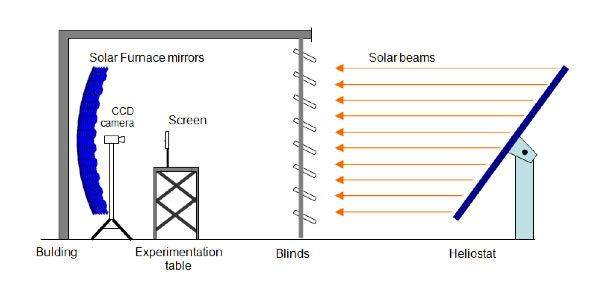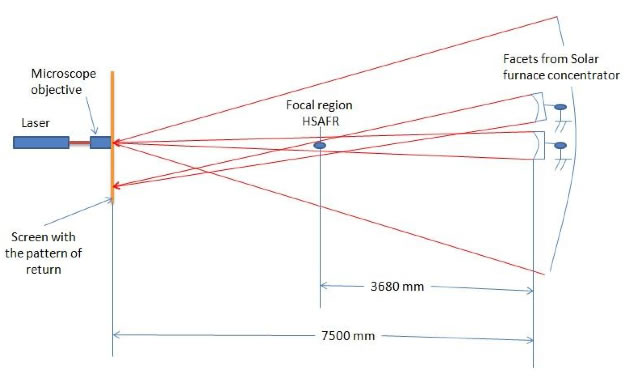Mostrando artículos por etiqueta: 2011 Memorias
Concentration Image Profiles of the High-Flux Solar Furnace of CIE-UNAM in Temixco, Mexico. First Stage
Abstract
In the present work, the analysis of the first images obtained from de Solar Furnace of High Radiative Flux in Mexico is presented. The solar furnace has five different focal distance groups. The images were acquired using the first two groups of mirrors from complete optics of main concentrator. We used a Heliostat with a reflective surface of 36 m². The Images was captured with a CCD camera and the irradiance profile was modeled with a ray-tracing program in order to estimate the global optical error for the concentrator-heliostat optical system. The results shows that the optical error is less to 3 mrad and the calculations indicates that the flux peak for the complete groups of mirrors could be higher than 12 000 suns and the average flux could be higher than 5,000 suns.
David Riveros-Rosas, Carlos A. Perez-Rabago, Camilo A. Arancibia-Bulnes, Ricardo Perez-Enciso, and Claudio A. Estrada

A New High-Flux Solar Furnace at CIE-UNAM in Temixco, México. First Stage
Abstract
A new high flux solar furnace facility has been developed in Mexico. It is located in Temixco, Morelos, Mexico and in its first phase of development consists of a heliostat of 36 square meters (6 m by 6 m), a shutter made of stainless steel blades 6.2 m by 6.2 m, and a multifaceted concentrator of 211 spherical mirrors with an equivalent focal length of 3.64 m. In order to set the HFSF in operation, all the mirrors were aligned, the control system was developed and tested, the heliostat was aligned and its tracking movement tested. The purpose of this paper is to present the new facility and its first results in the evaluation of its capacities. The results show that the optical error is less to 3 mrad and the calculations indicates that the average flux could be higher than 5,000 suns and the facility can reach temperatures as high as 3406º C.
A New High-Flux Solar Furnace at CIE-UNAM in Temixco, México. First Stage
Claudio A. Estrada, Camilo A. Arancibia-Bulnes, Sergio Vazquez, Carlos A. Pérez-Rábago, David Riveros, Ricardo Perez-Enciso, Jesús Quiñones, Rafael Castrejón, Moises Montiel, Fermín Granados

Method for Facets’ Alignment for the High-Flux Solar Furnace at CIE-UNAM in Temixco, Mexico. First Stag
Abstract
The new high radiative flux solar furnace is being developed in Mexico at the Centro de Investigación en Energía of the Universidad Nacional Autónoma de México. The alignment of the facets of the concentrator is a key procedure to obtain the required energy distribution in the focal zone and to keep the global standard deviation of the optical errors low. We present a novel method for optical alignment of the facets; this alignment procedure requires a simple optical system, allows rapid alignment and guarantees the required accuracy. Preliminary results obtained with this procedure are discussed, which show that the facets alignment satisfactorily meets specifications.
S. Vazquez-Montiel, C.A. Pérez-Rábago, R. Pérez-Enciso, D. Riveros-Rosas, F. Granados-Agustin, C.A. Arancibia-Bulnes, C.A. Estrada

Control System for the High-Flux Solar Furnace of CIE-UNAM in Temixco, Mexico. First Stage
Abstract
This paper presents the control system design of a new high flux solar furnace that is being developed in Mexico at the Center for Energy Research of the National University of Mexico. The control of the whole system is critical for the correct operation of it. The control system consists of a rugged PC running state machine-based software which manages the operation of all the user interfaces for the furnace systems which are the heliostat, shutter, cooling, visual and data acquisition subsystems, as well as the positioning desk control. The control routines run in real-time controllers dedicated for each subsystem. The computer routines used by the main program and the tests made for characterizing the heliostat follow-up system is also described. Preliminary results obtained shows that the heliostat control presents great versatility due to the type of control it has, including the possibility of accepting feedback through images projected by it.
C.A. Pérez-Rábago, R. Guzmán-Galán, N. Flores-Guzmán, E. Brito, D. Marroqui-García, R. Pérez-Enciso, D. Riveros-Rosas, C.A. Arancibia-Bulnes, C.A. Estrada
Control System for the High-Flux Solar Furnace of CIE-UNAM in Temixco, Mexico. First Stage

Heliostat Testing at a New Facility in Sonora, Mexico
Abstract
A new facility known as Heliostat Test Field has been developed in Mexico. It consists of a solar tower, a laboratory, and 16 heliostats. Three different optical tests have been implemented for the evaluation of heliostats at this installation: sun tracking test, reflected spot test, and deflectometry test. These tests allow the evaluation of tracking, and slope errors of the heliostats. In particular, the later provides detailed slope maps of the reflecting mirrors
Heliostat Testing at a New Facility in Sonora, Mexico
Camilo A. Arancibia-Bulne s, Manuel I. Peña-Cruz, David Marroquín-García, Rafael E. Cabanillas, Carlos A. Pérez-Rábago, David Riveros-Rosas, Jesús F. Hinojosa and Claudio A. Estrada

Advanced Oxidation Processes for Waste Water Treatment at Pilot Plant Level Using Solar Radiation
Abstract
Due to water pollution at urban as well as industrial and rural level, there exists the need to introduce and improve new alternative technologies to traditional methods for waste water treatment. It is important that new technologies must be economic, effective and environment friendly. The above mentioned alternative technologies are in this case the heterogeneous photocatalysis with TiO2 and photo-Fenton processes which use the solar radiation as exciting source to produce species highly oxidative that can degrade the organic matter present in polluted water. This paper describes the construction of a Photocatalytic Solar Plant located at the installations of the Energy Research Center of the National University of Mexico (CIE-UNAM), which is composed by different photocatalytic reactor integrated with CPC solar concentrators whose concentration varies between 1 and 2 suns. The photoreactors and equipped with temperature, pH, COD and DO online sensors. Moreover, the plant counts with an analytical laboratory equipped with a Total Organic Carbon(TOC) analyzer and a UV-VIS spectrophotometer. In addition, immobilized TiO2 photocatalysts on glass pipes Pyrex® were prepared, which lately were introduced into the photocatalytic reactor. The catalyst immobilization on glass pipes eliminates in an effective way the recovery process of powder photocatalysts, and also saves time and work costs. The technical feasibility and performance of the photocatalytic degradation of the plaguicide carbaryl at pilot level have been here studied.
Ivan SalgadoTránsito, Antonio E. Jiménez González, Claudio A. Estrada Gasca, Camilo Arancibia Bulnes, Rogelio Morán Elvira, Carlos Antonio Pineda Arellano, Eduardo Iragorri, Cesar Pérez Franco and Emmanuel Hernández Martínez

